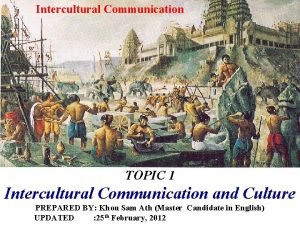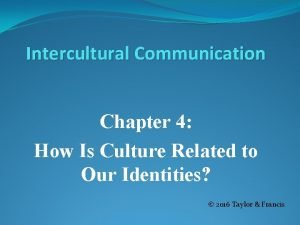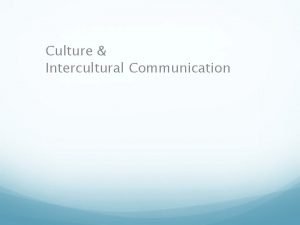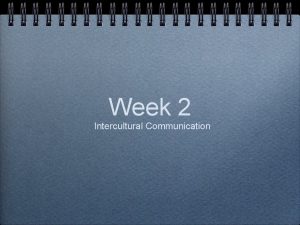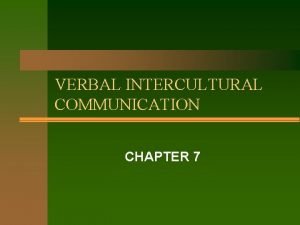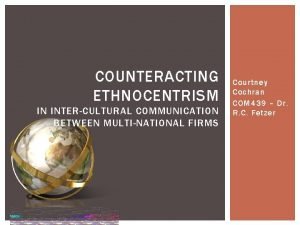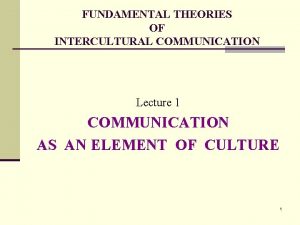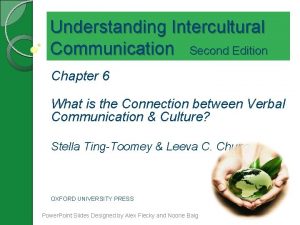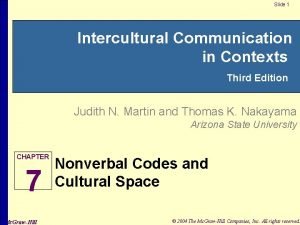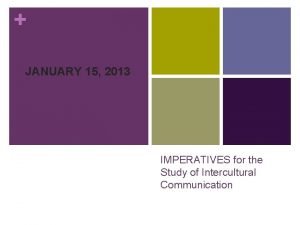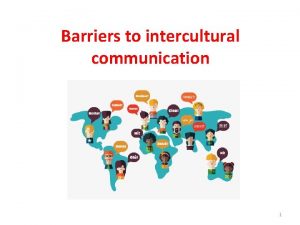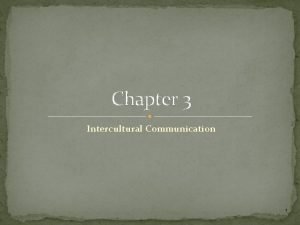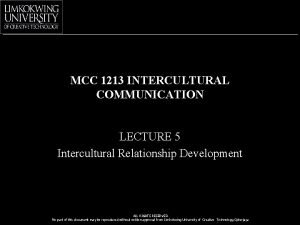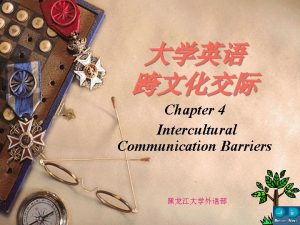Communication Culture and Intercultural Communication http www zzone



















- Slides: 19

Communication, Culture and Intercultural Communication http: //www. zzone. cn 中国. 中学政治教学网崇尚互联共享

Objectives • Understand such terms as communication, culture, and intercultural communication • Understand the steps and the types of communication • Understand the functions and characteristic of culture • Understand the forms of intercultural communication http: //www. zzone. cn 中国. 中学政治教学网崇尚互联共享

1. How many steps are included in a communication process? What are they? • A complete communication process includes 8 steps. – behavior source: the speaker; – encoding: the internal activities of the speaker when organizing the message; – message: the result of the encoding is a message once it is send and received; – channel: the physical medium with which the message is transferred; http: //www. zzone. cn 中国. 中学政治教学网崇尚互联共享

– responder: the person who receives and responds to the speaker’s message; – decoding: the internal activities of the responder when decoding the message; – response: the action taken by the responder, including making response or making no response, after decoding; – feedback: the response is a feedback once it is received by the speaker. http: //www. zzone. cn 中国. 中学政治教学网崇尚互联共享

2. What will contribute to communication? • Two groups of variables: personal and nonpersonal. • Personal elements: stable and non-stable elements. • Stable elements: sex; age; personality; profession; social status; education; life experience. http: //www. zzone. cn 中国. 中学政治教学网崇尚互联共享

• Unstable elements: intention; feeling; identity. • Non-personal elements: time; place; occasion. http: //www. zzone. cn 中国. 中学政治教学网崇尚互联共享

3. How can communication be defined? • According to Professor Frank Dance from Wisconsin University, there are more than 126 definitions for the term “communication”; • Samovar defined communication as “that which happens whenever someone responds to the behavior or the residue of the behavior of another person” ; • Implications in Samovar’s definition: (1) behavior consists of verbal behavior and nonverbal behavior; (2) behavior residue is the trace left behind by certain behavior and should be taken into consideration in defining “communication”; (3) it is the response rather than speaker’s intention that should be stressed; (4) Feed is not the indispensible part of a communication process. http: //www. zzone. cn 中国. 中学政治教学网崇尚互联共享

4. How can communication be classified? • According to different criterion, communication can be classified in different ways. • The symbol used: verbal or nonverbal communication. • The media used: direct or indirect. • Feedback: two way or one way. • The numbers of speakers and respondents: one/group-to-one or one/group-to-group. http: //www. zzone. cn 中国. 中学政治教学网崇尚互联共享

• Fixed respondents: directed or nondirected. • The intention of speakers: intentional or uninterntional. • The attitude of respondents: active or passive. • The time when communication occurs: simultaneous or nonsimultaneous. http: //www. zzone. cn 中国. 中学政治教学网崇尚互联共享

5. What is the working definition of “communication” in the book? • Communication can be defined as “that which happens whenever one (or more) people respond (s) to other person (s)’ behavior (s) or residue of behavior (s)”. http: //www. zzone. cn 中国. 中学政治教学网崇尚互联共享

6. How can “culture” be defined? • According to Qi Yucun, there are more than 250 definitions for culture. • A well-acknowledged classic definition was the one given by Edward Taylor, a famous anthropologist, defines culture as “a complex whole which includes knowledge, belief, art, morals, law, custom, and any other capabilities and habits acquired by man as a member of the society. http: //www. zzone. cn 中国. 中学政治教学网崇尚互联共享

• Culture can be defined in its broad sense or in its narrow sense. • Culture is also divided into “Culture with a big C” and “Culture with a small C”. http: //www. zzone. cn 中国. 中学政治教学网崇尚互联共享

7. What are the characteristics of culture? • • • culture culture norms; • culture http: //www. zzone. cn is holistic; is learned; is dynamic; is pervasive; is a set of shared perceptions; involves beliefs, values, and affects behavior; involves large group of people. 中国. 中学政治教学网崇尚互联共享

8. What is the working definition of “culture” in this book? • From the perspective of human development, culture can be defined as “the comprehensive features that differ human beings from other animals; • From the perspective of the evolution and development of the culture and the distribution of the human being, culture can be considered as “the comprehensive features which differ one ethnic group from another” on one hand “ the comprehensive features that differ one group from another” on the other hand. • ethnic group--- subgroup; culture---subculture. http: //www. zzone. cn 中国. 中学政治教学网崇尚互联共享

9. What is intercultural communication? • Based on the definition of communication, “intercultural communication” may be simply defined as “that which happens whenever one (or more) people from one culture respond (s) to the behavior (s) or the residue of behavior (s) of other person (s) from another culture. http: //www. zzone. cn 中国. 中学政治教学网崇尚互联共享

10. What are three contributors to successful intercultural communication? • (1) the positive feeling we possess at the affective level, including affirmation, self-esteem, comfort, trust, and safety; (2) the beliefs we bring into the intercultural encounter at the cognitive level, including expectations, stereotypes, uncertainties, and misunderstanding of rules or procedures; (3) the actions or skills we possess at the behavioral level, including verbal and nonverbal communication skills in intercultural settings. http: //www. zzone. cn 中国. 中学政治教学网崇尚互联共享

11. What are three forms of intercultural communication? • self-centered dialogue[ethnocentrism--using their own cultural standards to judge and interact with each other--lack of understanding or unwilling to understand cultural differences; dominant centered dialogue---well aware of cultural differences, but try to impose one’s cultural standards on people from another culture---cultural imperialism; and equal dialogue--mutual understanding of cultural similarities and differences and sincere efforts to overcome their difference on an equal basis---successful communication. http: //www. zzone. cn 中国. 中学政治教学网崇尚互联共享

12. What are the significance of Intercultural Communication Studies? • Significance: Intercultural communication studies, focused on the equal dialogue, help to reduce communication barriers, to prevent intercultural conflicts, and to promote intercultural communication. http: //www. zzone. cn 中国. 中学政治教学网崇尚互联共享

13. What are the traps? • (1) Overlook the dynamic development of culture; (2) Mistakenly dismiss features of an individual as group features; (3) insufficiently understand the limitation of “cultural stereotype”. Stereotype--- those overgeneralized and oversimplified beliefs we use to categorize a group of people--Americans walk very fast; Americans are very straightforward in talking; American students ask too much questions in the classroom and don’t respect professors. http: //www. zzone. cn 中国. 中学政治教学网崇尚互联共享
 Technology and intercultural communication
Technology and intercultural communication Stereotyping in communication barriers
Stereotyping in communication barriers Example of a low context culture
Example of a low context culture Intercultural communication questions
Intercultural communication questions Reactive ascription
Reactive ascription Intercultural communication youtube
Intercultural communication youtube Intercultural communication notes
Intercultural communication notes Staircase model of intercultural communication
Staircase model of intercultural communication Paraverbal communication definition
Paraverbal communication definition Nonverbal communication codes
Nonverbal communication codes Intercultural communication conclusion
Intercultural communication conclusion Ethnocentrism intercultural communication
Ethnocentrism intercultural communication Intercultural communication model
Intercultural communication model The totality of a groups thought experiences and patterns
The totality of a groups thought experiences and patterns Strategies for improving intercultural communication
Strategies for improving intercultural communication Intercultural communication 2nd edition
Intercultural communication 2nd edition Intercultural communication in contexts
Intercultural communication in contexts Demographic imperative intercultural communication
Demographic imperative intercultural communication 4 barriers of intercultural communication
4 barriers of intercultural communication Non material culture definition
Non material culture definition


